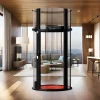Elevators are an essential component of modern buildings, providing a convenient and efficient means of vertical transportation. However, ensuring the safety of elevator systems is crucial for protecting passengers and maintaining the overall integrity of a building. Understanding the key aspects of elevator safety and implementing best practices can significantly reduce the risk of accidents and malfunctions. This article explores how to ensure elevator safety in your building, addressing common concerns and highlighting effective safety measures.
Are Elevators Safe?
Elevators are generally considered to be one of the safest modes of transportation. According to the National Elevator Industry, Inc. (NEII), elevators in the United States alone make over 18 billion passenger trips each year, with a very low incidence of accidents. Modern elevators are equipped with numerous safety features and are subject to stringent regulations and standards to ensure their safe operation.
Key Safety Features of Elevators
- Emergency Brakes: Engage automatically if the elevator car travels too fast or free-falls, stopping the car safely.
- Overspeed Governors: Monitor the speed of the elevator car and trigger the emergency brake if the car exceeds its maximum speed limit.
- Door Sensors: Detect obstructions in the doorways, preventing the doors from closing on passengers or objects.
- Backup Power Systems: Allow the elevator car to move to the nearest floor and open the doors in the event of a power outage.
- Interlocks: Ensure the elevator car will not move unless the doors are securely closed and locked.
- Safety Gear: Engage if the elevator car exceeds a certain speed or if the cables fail, stopping the car from free-falling.
How Safe Are Elevators?
The safety of elevators is upheld through rigorous design standards, regular inspections, and maintenance protocols. Ensuring the continued safety of an elevator system requires proactive measures and a commitment to best practices.
Best Practices for Elevator Safety
1. Regular Inspections and Maintenance
Routine inspections and maintenance are crucial for ensuring the safe operation of elevators. Building owners and managers should schedule regular maintenance checks with certified elevator technicians to inspect all components, identify potential issues, and perform necessary repairs. Adhering to a preventative maintenance schedule helps prevent malfunctions and extends the lifespan of the elevator system.
2. Compliance with Safety Regulations
Elevators must comply with local, national, and international safety regulations and standards, such as those set by the American Society of Mechanical Engineers (ASME) and the International Organization for Standardization (ISO). Additionally, at our company, we ensure compliance with ISO certification and follow EN-81 safety standards to maintain elevator safety and avoid legal liabilities.
3. Upgrading and Modernizing Older Systems
Older elevator systems may lack modern safety features and technologies. Upgrading and modernizing these systems can enhance their safety and performance. Consider installing advanced safety mechanisms, energy-efficient components, and modern control systems to improve the overall safety and reliability of the elevator.
4. Implementing Safety Training Programs
Building staff and maintenance personnel should undergo regular safety training to ensure they are familiar with the proper operation and emergency procedures related to the elevator system. Training programs should cover topics such as emergency evacuation, responding to malfunctions, and safe maintenance practices.
5. Monitoring and Remote Diagnostics
Modern elevators can be equipped with monitoring and remote diagnostic systems that continuously track their performance and identify potential issues before they escalate. These systems can provide real-time data and alerts to maintenance teams, allowing for prompt and proactive interventions.
6. Educating Passengers
Educating passengers on safe elevator use can also contribute to overall safety. Display clear and easy-to-understand safety instructions inside the elevator car and near the doors. Encourage passengers to report any unusual noises, jerky movements, or other signs of malfunction to building management immediately.
7. Emergency Preparedness
Prepare for emergencies by having a clear plan in place. Ensure that emergency communication systems, such as intercoms or alarm buttons, are functional and accessible. Regularly test backup power systems and emergency lighting to ensure they operate correctly during a power outage.
Conclusion
Elevators are a safe and reliable means of transportation when properly maintained and operated. Ensuring elevator safety in your building involves adhering to regular maintenance schedules, complying with safety regulations, upgrading older systems, and educating both staff and passengers on safe practices. By implementing these best practices and adhering to ISO and EN-81 safety standards, building owners and managers can significantly enhance the safety and reliability of their elevator systems, providing peace of mind to all occupants.








